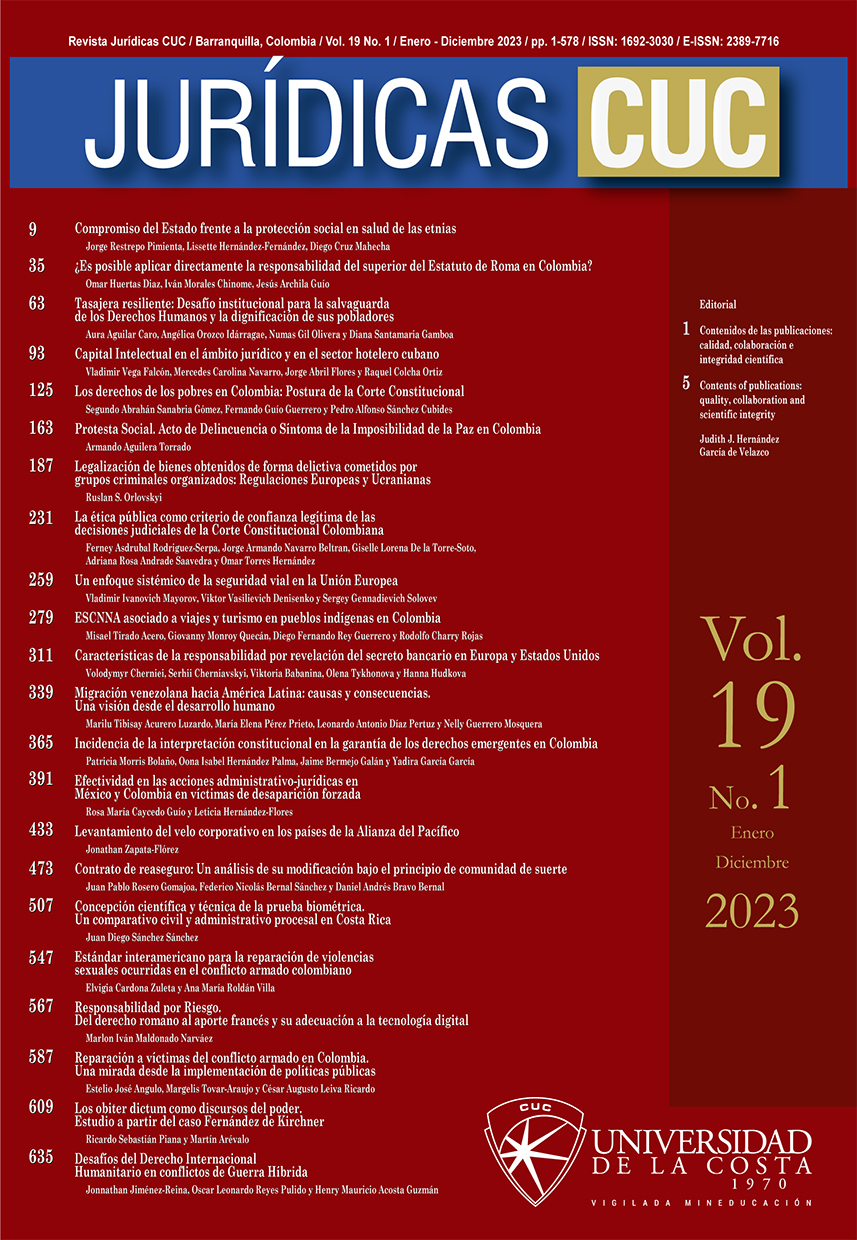Intellectual Capital in the legal field and in the Cuban hotel sector
DOI:
https://doi.org/10.17981/juridcuc.19.1.2023.04Keywords:
Intellectual capital, Legal ambit, Intangible assets, Hotel sector, Vega-Rivero modelAbstract
The objective was to assess intellectual capital including its legal scope in the hotel sector in Cuba. A case study was developed, applying an analytical research, with a longitudinal design. The Vega-Rivero model and procedure were used to measure intellectual capital. In addition, the expert method was applied to weight the calculations made, processing the information with the support of Microsoft Excel 2019 and SPSS software version 26. As a result, it is indicated that the measurement of intellectual capital showed an increase of 299.28 USD in the hotel under study when comparing the two months studied. Likewise, the adaptation of the Cuban legal environment to the requirements of the environment is rectified. It is concluded that the measurement of intellectual capital ratified the validity of the Vega-Rivero model and procedure; the results serve as support for future studies focused on measuring intellectual capital in hotel entities.
Downloads
References
Archibold, W. y Escobar, A. (2015). Capital intelectual y gestión del conocimiento en las contralorías territoriales del departamento del Atlántico. Dimensión Empresarial, 13(1), 133–146. http://ojs.uac.edu.co/index.php/dimension-empresarial/article/view/342
Armenteros, M. y Vega, V. (2000). Evolución histórica de la Contabilidad de Gestión en Cuba. En T. J. Balada y V. M. Ripoll (Coords.), Situaciones y tendencias de la Contabilidad de Gestión en el ámbito Iberoamericano (pp. 25–30). AECSA.
Bontis, N., Janošević, S. & Dženopoljac, V. (2015). Intellectual capital in Serbia’s hotel industry. International Journal of Contemporary Hospitality Management, 27(6), 1365–1384. https://doi.org/10.1108/IJCHM-12-2013-0541
Borrás-Atiénzar, F. y Campos-Chaurero, L. (2018). El capital intelectual en las empresas cubanas. Ingeniería Industrial, 39(1), 56–66. https://rii.cujae.edu.cu/index.php/revistaind/article/view/720
Bueno, E. (2013). El capital intelectual como sistema generador de emprendimiento e innovación. Economía industrial, 388, 15–22. https://www.mincotur.gob.es/Publicaciones/Publicacionesperiodicas/EconomiaIndustrial/RevistaEconomiaIndustrial/388/Eduardo%20Bueno.pdf
Costa, V., Silva, L. & Loureiro, P. (2020). Intellectual capital and its impact on business performance: An empirical study of Portuguese hospitality and tourism sectors. Intangible Capital, 16(2), 78–89. https://doi.org/10.3926/ic.1550
Cuervo, T., Blanco, A. y Del Castillo, C. (2021). Intangible assets and business results of large companies. Intangible Capital, 17(2), 108–123. https://doi.org/10.3926/ic.1390
Demuner, M, Saavedra, M y Camarena, M. (2017). Medición del capital intelectual en el sector bancario: aplicación de los modelos Skandia y VAIC. Innovar, 27(66), 75–89. https://doi.org/10.15446/innovar.v27n66.66712
Erazo-Álvarez, J. y Narváez-Zurita, C. (2020). Medición y gestión del capital intelectual en la industria del cuero - calzado en Ecuador. Revista Arbitrada Interdisciplinaria KOINONIA, 5(9), 437–467. https://doi.org/10.35381/r.k.v5i9.662
França, A y Rua, O. (2018). Relationship between intangible resources, absorptive capacities and export performance. Tourism & Management Studies, 14(1), 94–107. https://doi.org/10.18089/tms.2018.14108
Farrukh, W & Joiya, J. (2018). Impact of Intellectual Capital on Firm Performance. International Journal of Management and Economics Invention, 4(10), 1943–1952. http://www.rajournals.in/index.php/ijmei/article/view/417
Gómez-Bayona, L., Londoño-Montoya, E. y Mora-González, B. (2020). Modelos de capital intelectual a nivel empresarial y su aporte en la creación de valor. Revista CEA, 6(11), 165–184. https://doi.org/ 10.22430/24223182.1434
IBM. (2017). Statistical Package for the Social Sciences (version 26). [Software]. IBM. https://www.ibm.com/support/pages/downloading-ibm-spss-statistics-26
Melian, G. (2018). Liquidación de activos intangibles en las empresas mixtas cubanas. Revista la propiedad inmaterial, (26), 5–27. https://doi.org/10.18601/16571959.n26.01
Mercado-Salgado, P. (2016). Validity of a Scale Measuring Intellectual Capital in Universities. Universitas Psychologica, 15(2), 109–120. http://dx.doi.org/10.11144/Javeriana.upsy15-2.viem
Miotto, G., Del-Castillo-Feito, C., y Blanco-González, A. (2020). Reputation and legitimacy: Key factors for Higher Education Institutions’ sustained competitive advantage. Journal of Business Research, 112, 342–353. https://doi.org/10.1016/j.jbusres.2019.11.076
Montané-Marsal, N y Cuesta-Santos, A. (2020). Activos intangibles y su influencia en la eficiencia económica de un banco cubano. Ingeniería Industrial, 41(3), 1–12. https://rii.cujae.edu.cu/index.php/revistaind/article/view/1064
Ordoñez, E., Barrera, H. y Abril, J. (2019). La Sociedad del conocimiento enfocado al capital intelectual empresarial. 593 Digital Publisher CEIT, 4(6), 74–94. https://doi.org/10.33386/593dp.2019.6.129
Orobio, A., Rodríguez, E. M. y Acosta, J. C. (2019). Análisis del impacto de implementación de las normas internacionales de información financiera (NIIF) en el sector industrial de Bogotá para PYMEs. Cuadernos De Contabilidad, 19(48), 1–18. https://doi.org/10.11144/Javeriana.cc19-48.aiin
Ortega, Z., Mijares, B. y Luengo, E. (2022). Del reconocimiento y la autoestima en los relatos de mujeres. Orbis Revista Científica Electrónica de Ciencias Humanas, 51(17), 18–33. http://www.revistaorbis.org/contenido/contenido56-1.html
Pardo, M., Herrera, R y Rueda, L. (2017). Valoración del capital intelectual y su impacto en la rentabilidad financiera en empresas del sector industrial del Ecuador. Revista Publicando, 4(13-1), 193–206. https://revistapublicando.org/revista/index.php/crv/article/view/785
Pardo-Cueva, M., Armas, R. e Higuerey, A. (2018). La influencia del capital intelectual sobre la rentabilidad de las empresas manufactureras ecuatorianas. Revista Espacios, 39(51), 1–11. https://www.revistaespacios.com/a18v39n51/18395114.html
Pastor, D., Glova, J., Lipták, F. & Kováč, V. (2017). Intangibles and methods for their valuation in financial terms: Literature review. Intangible Capital, 13(2), 387–410. http://doi.org/10.3926/ic.752
Rivero, D., Vega, V. y Balagué, J. (2003). Importancia del Capital Intelectual en el turismo. Retos Turísticos, 2(2), 1–8. https://www.researchgate.net/publication/330899792_Importancia_del_Capital_Intelectual_en_el_Turismo
Serenko, A. & Bontis, N. (2013). Investigating the current state and impact of the intellectual capital academic discipline. Journal of Intellectual Capital, 14(4), 476–500. https://doi.org/10.1108/JIC-11-2012-0099
Vaz, C., Seling, P. & Viegas, C. (2019). A proposal of intellectual capital maturity model (ICMM) evaluation. Journal of Intellectual Capital, 2(20), 208–234. https://doi.org/10.1108/JIC-12-2016-0130
Vega, V. (2018). Sinergia positiva entre la consultoría organizacional y la investigación: caso real. Res Non Verba, 8(2), 19–37. https://biblio.ecotec.edu.ec/revista/articulo.php?id=301
Vega, V. (2017). Una mirada al concepto de Capital Intelectual. UNIANDES Episteme, 4(4), 491–503. http://45.238.216.13/ojs/index.php/EPISTEME/article/view/825
Vega, V. (2016). Medición del capital intelectual. Editorial Jurídica del Ecuador.
Vega, V. y Rivero, D. (2018). Modelo de medición de activos intangibles. ECOCIENCIA, 5(3), 1–32. https://doi.org/10.21855/ecociencia.53.67
Downloads
Published
How to Cite
Issue
Section
License
Copyright (c) 2023 JURIDICAS CUC

This work is licensed under a Creative Commons Attribution-NonCommercial-NoDerivatives 4.0 International License.
The authors are exclusively responsible for the published articles, which do not necessarily reflect the views of the editorial committee.
JURIDICAS CUC respects the moral rights of authors who have assigned the property rights on the published materials to the editorial committee. In turn, the authors declare that the work they submit has not been previously published.


 English
English
 Español (España)
Español (España)



